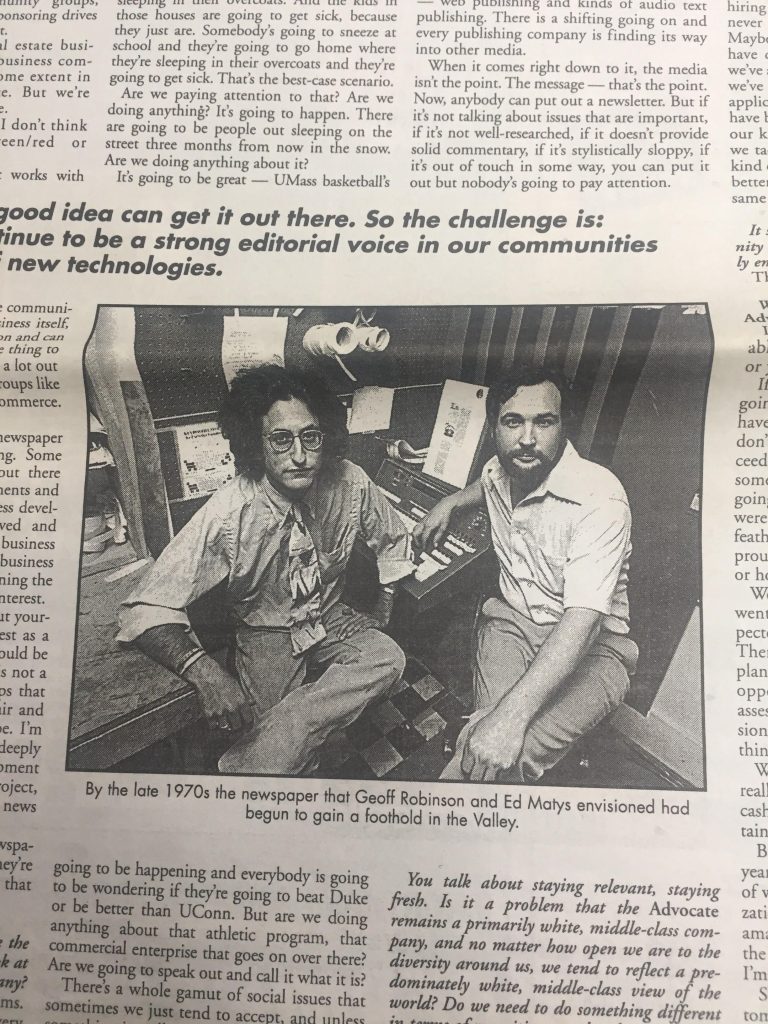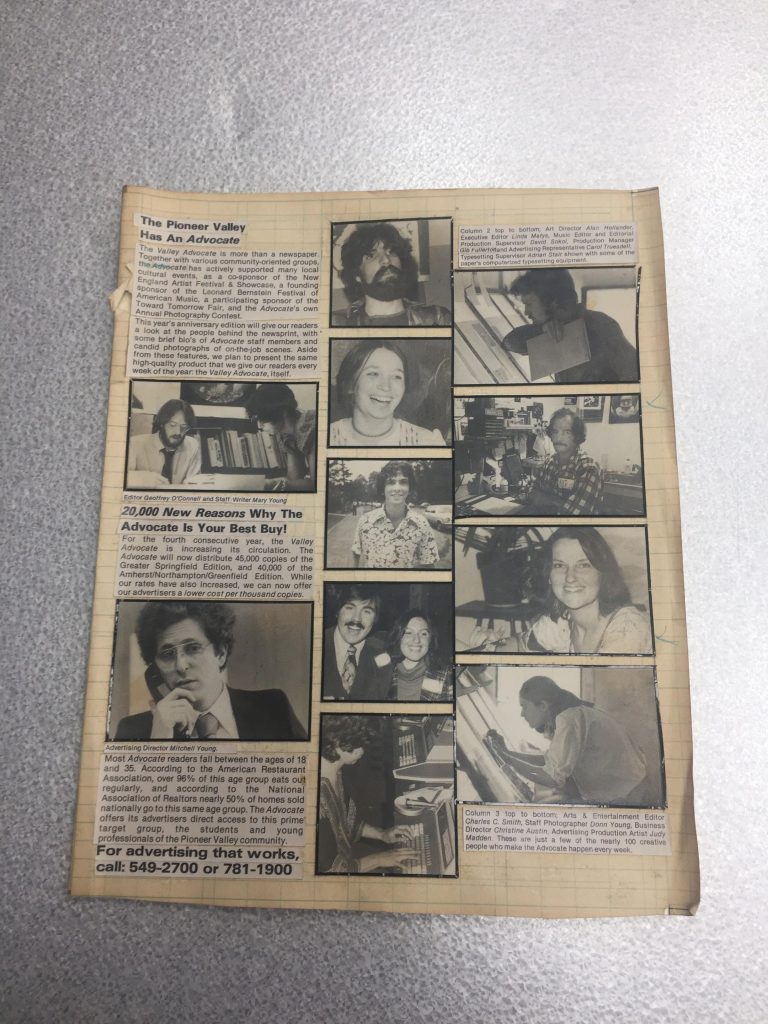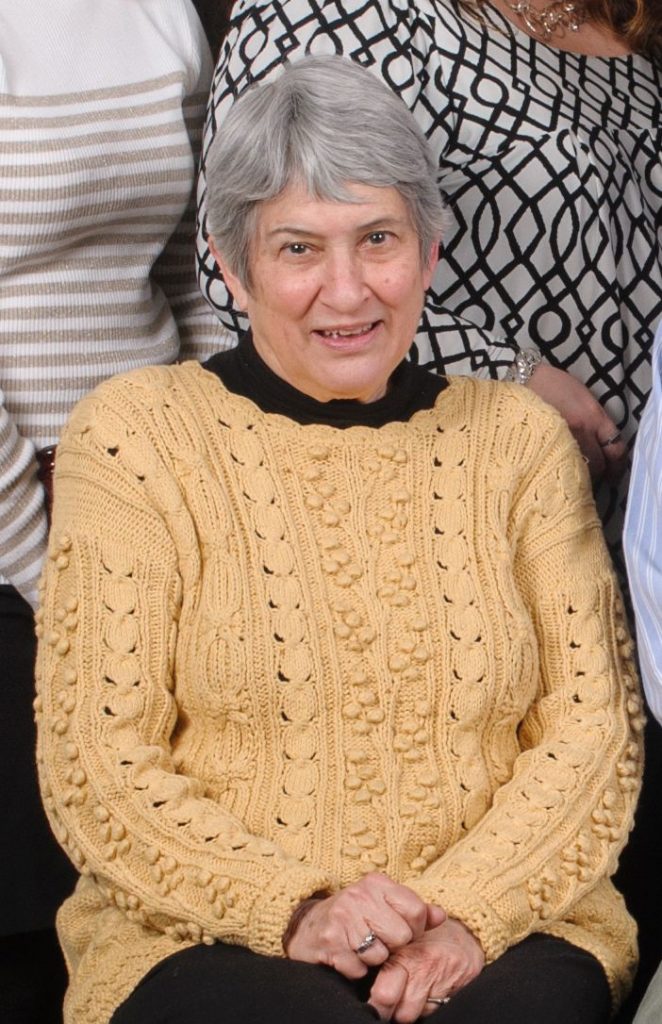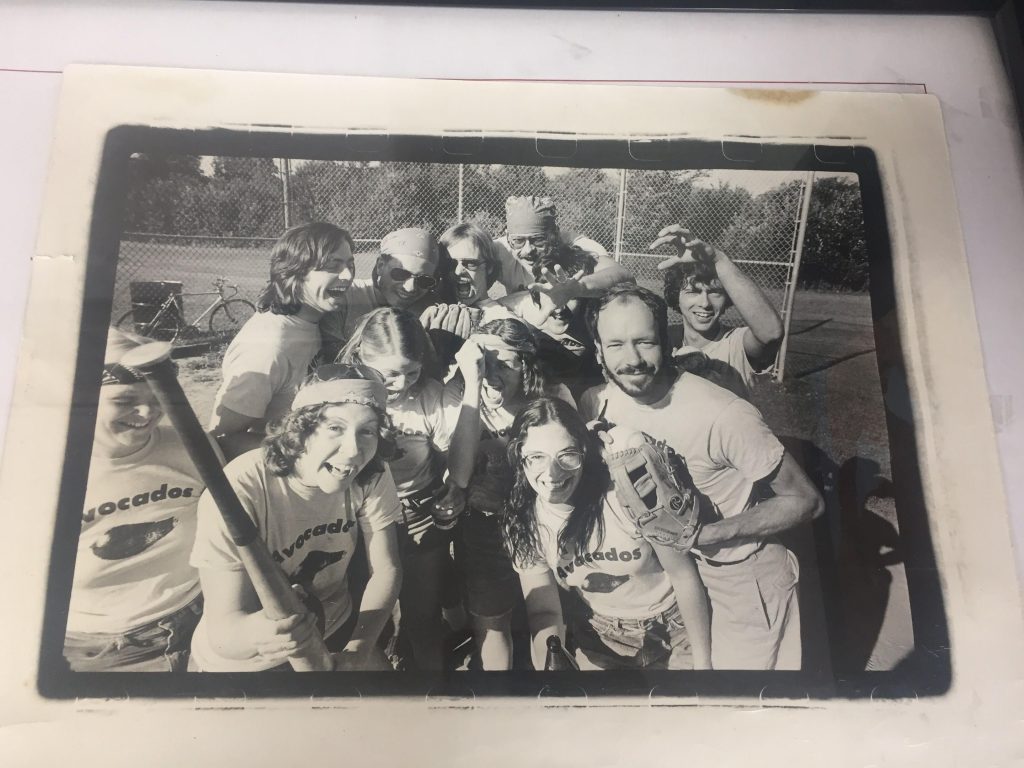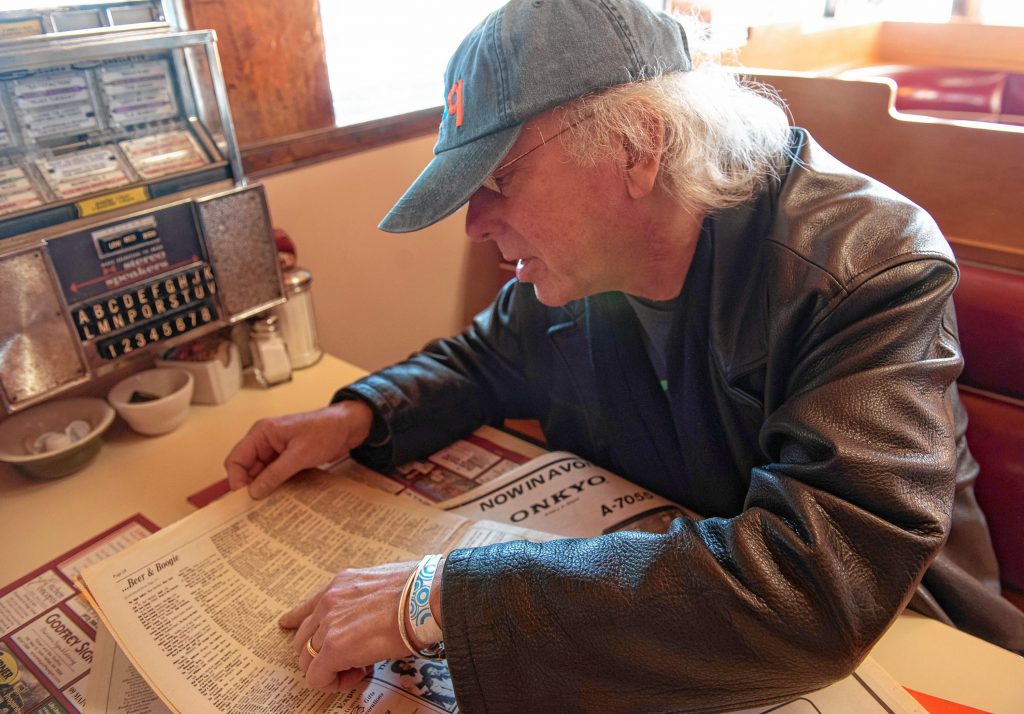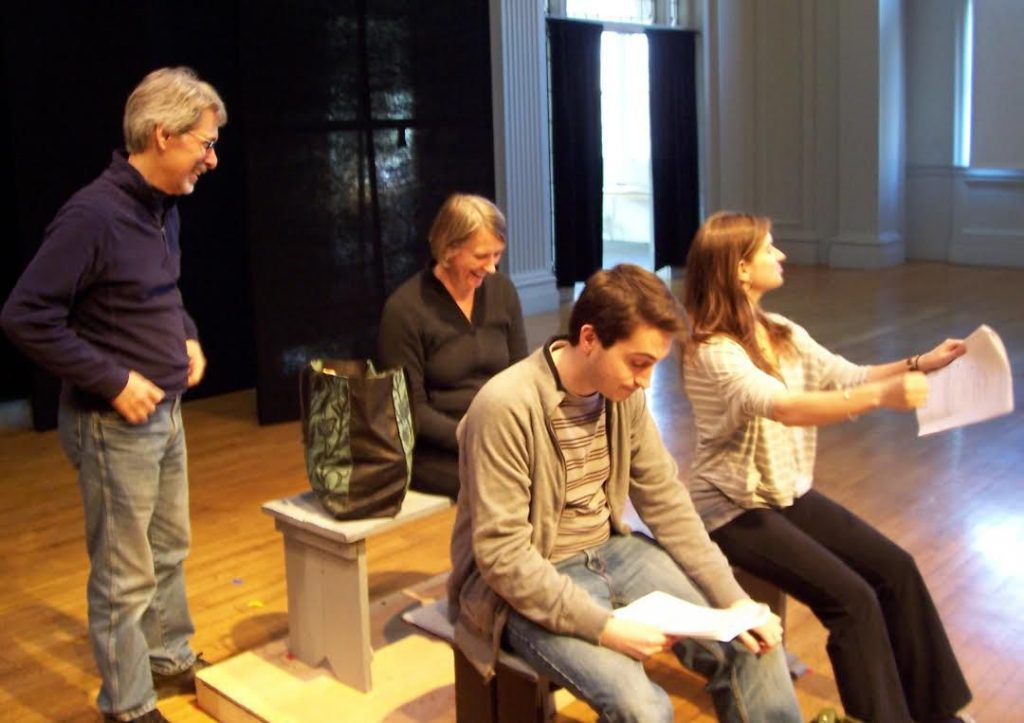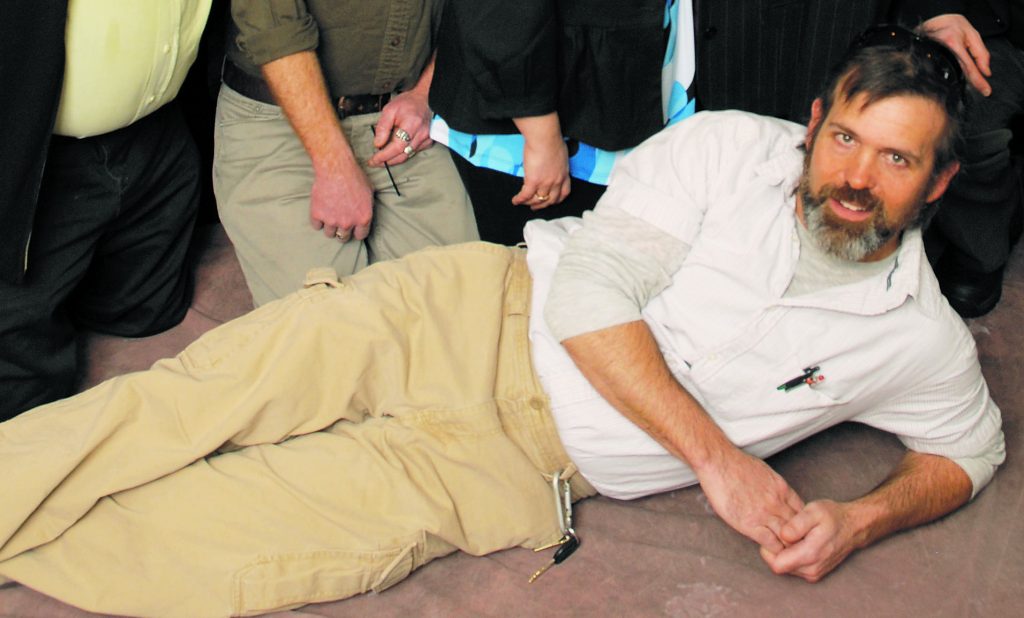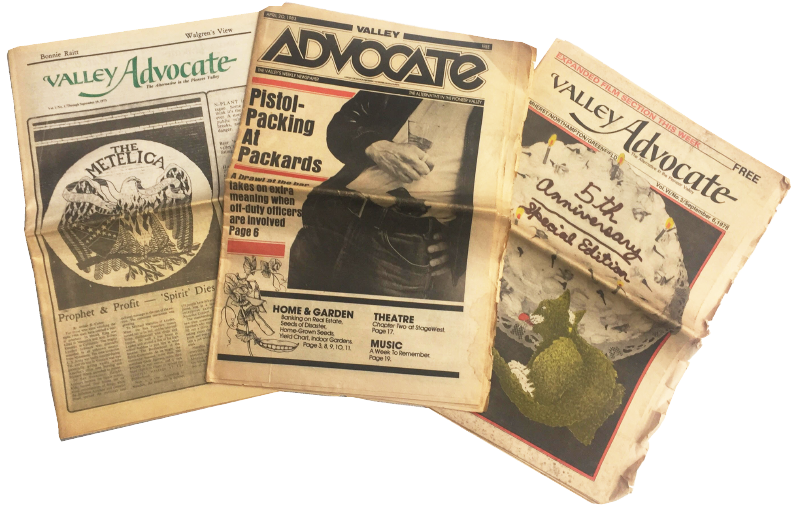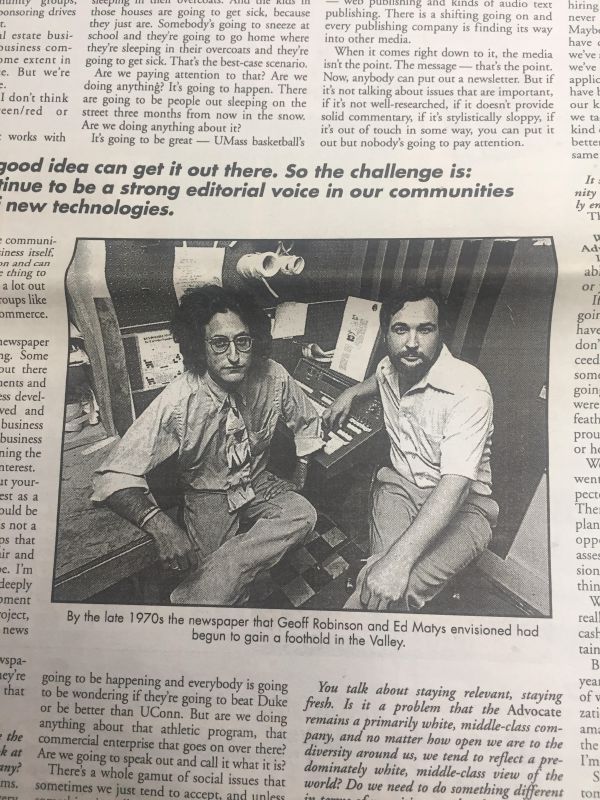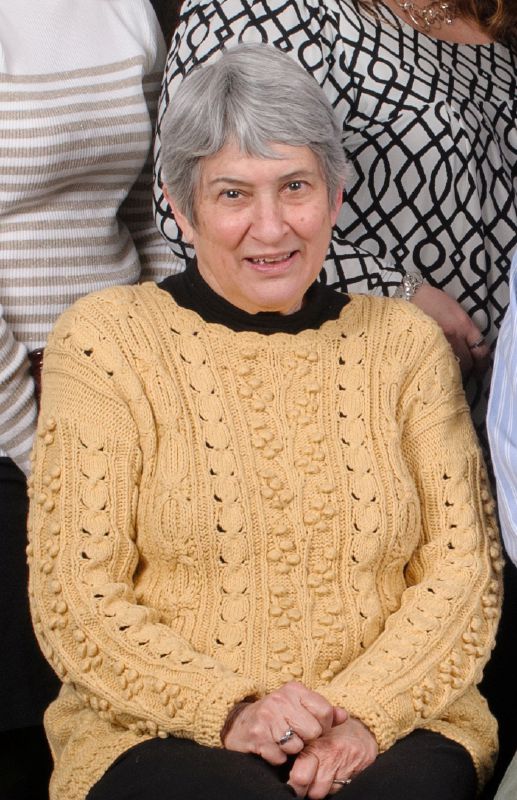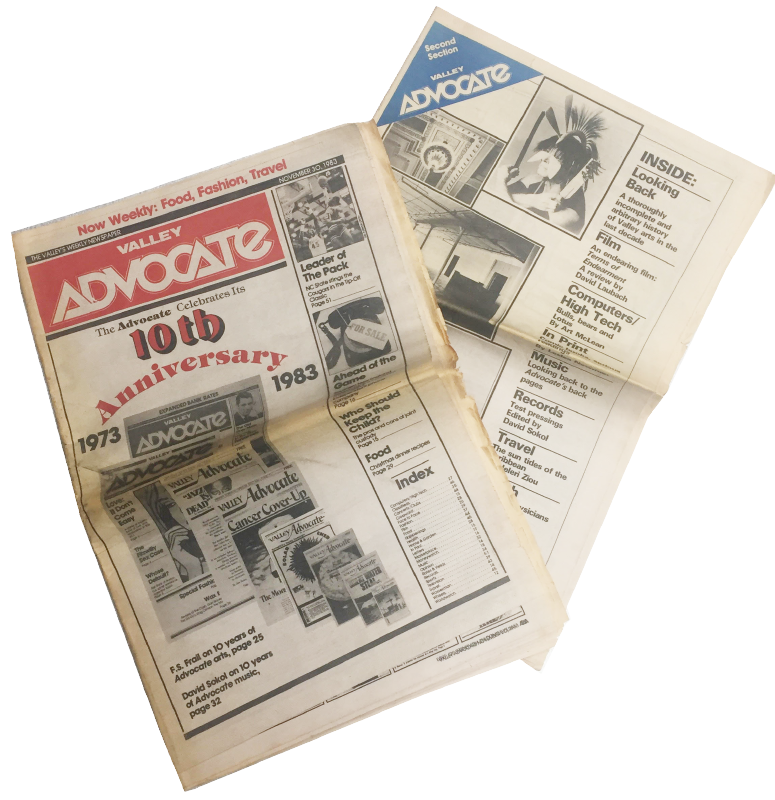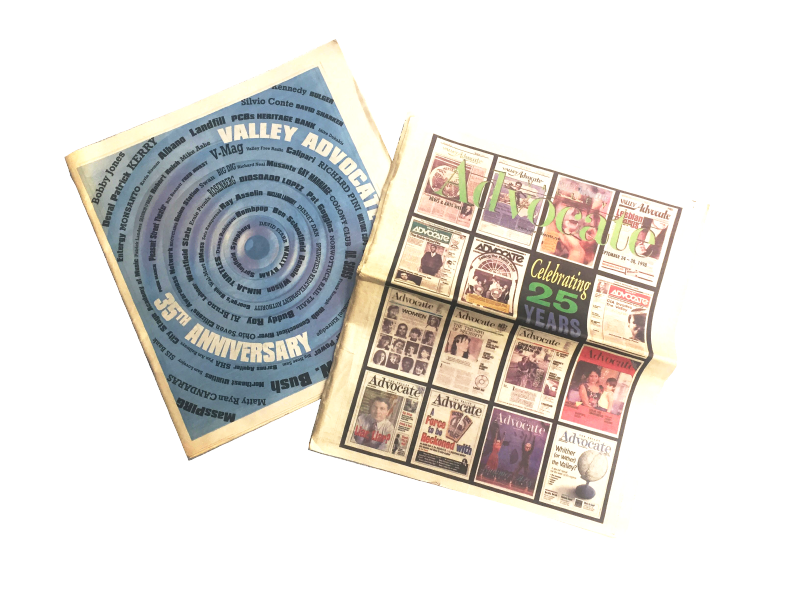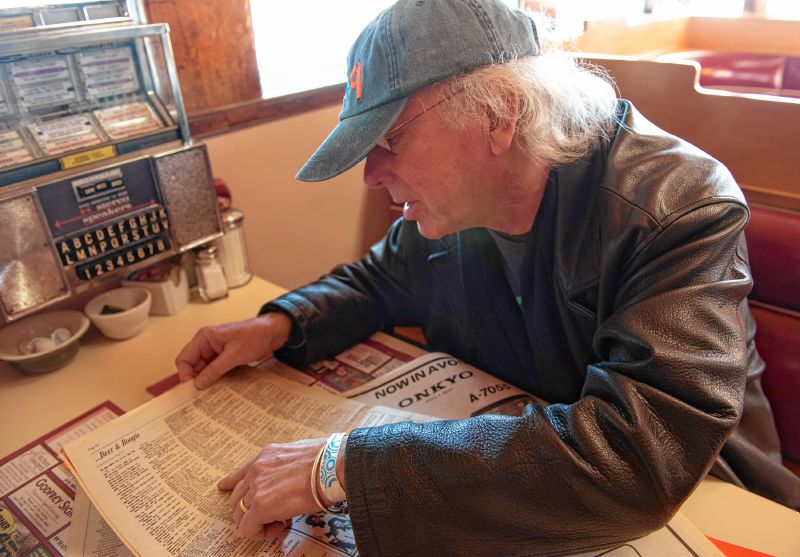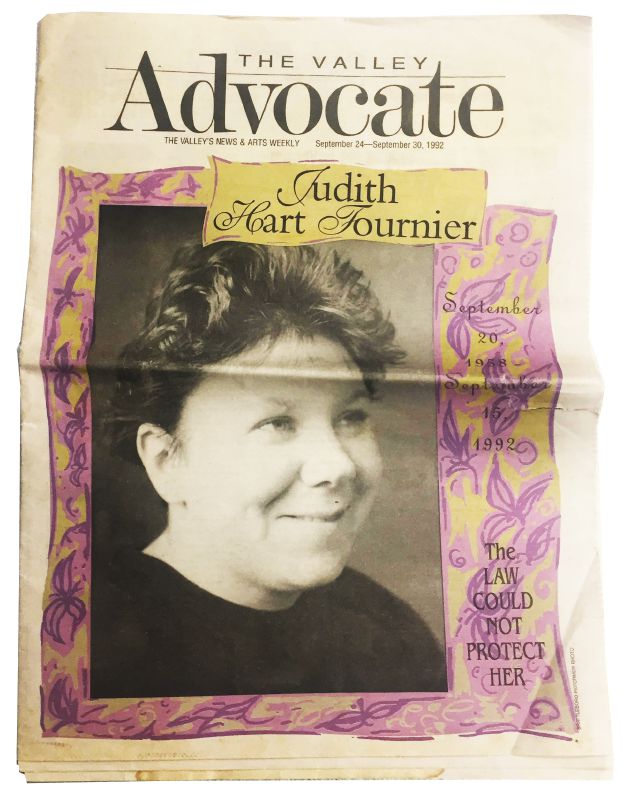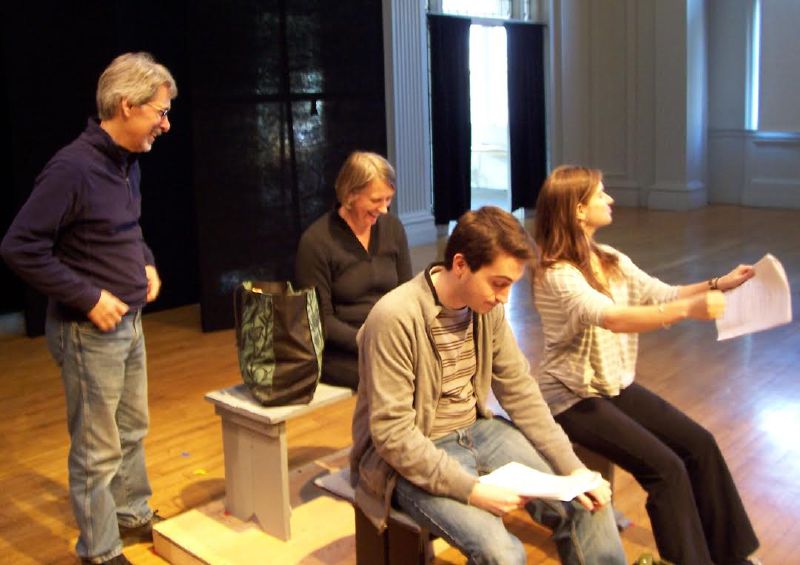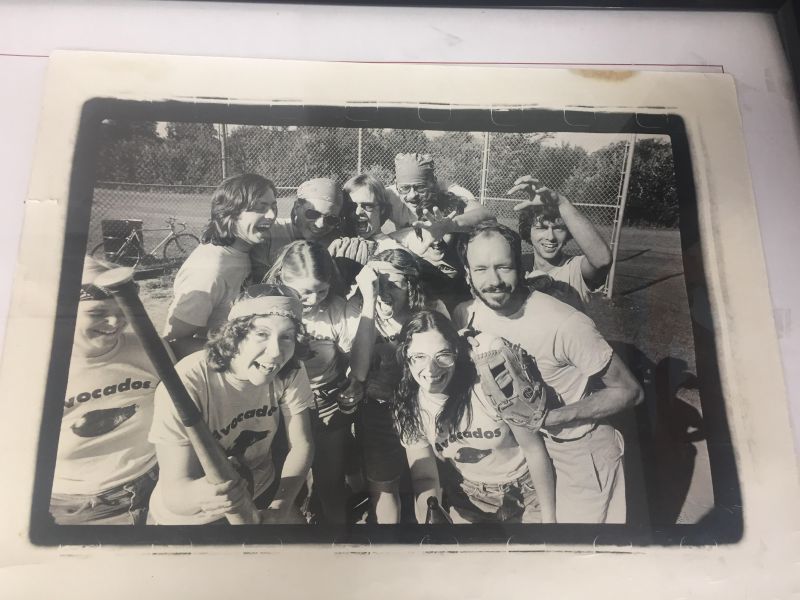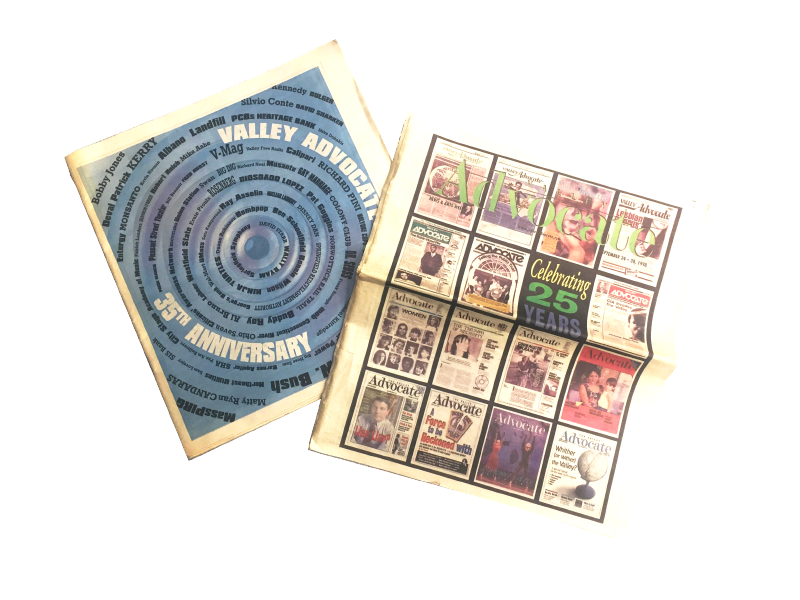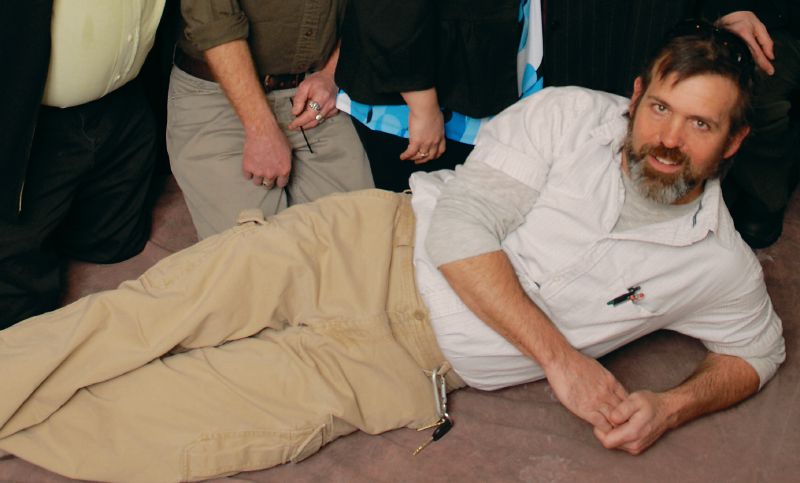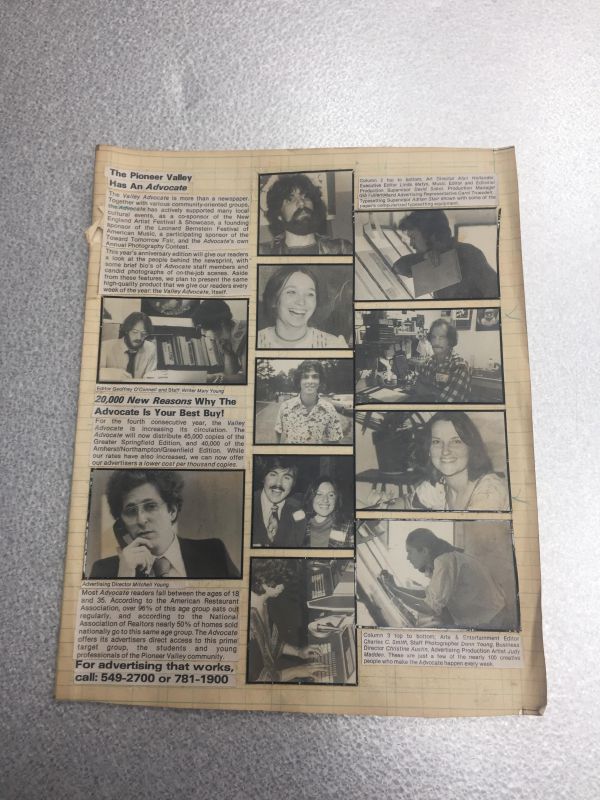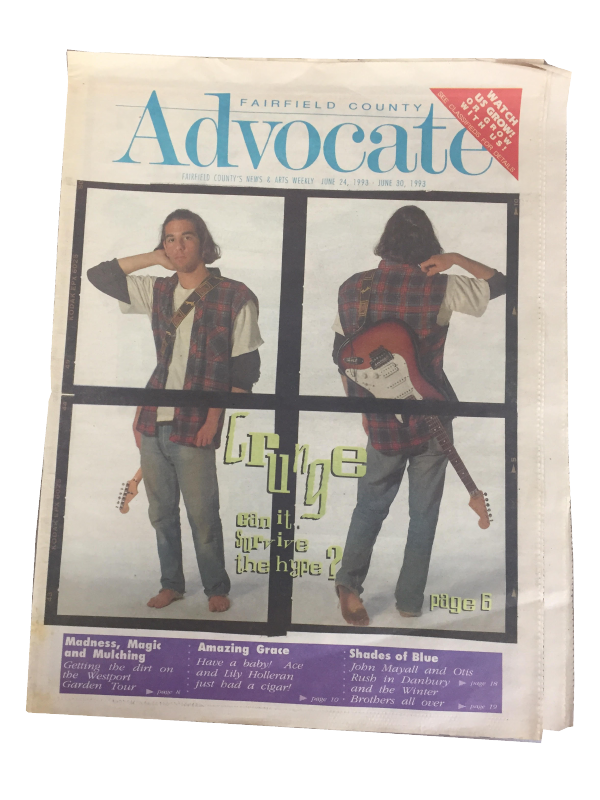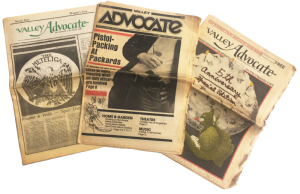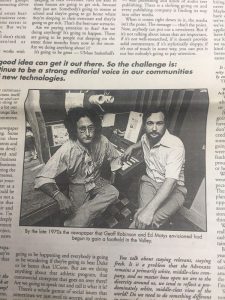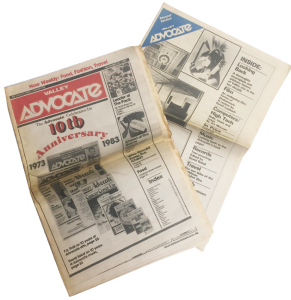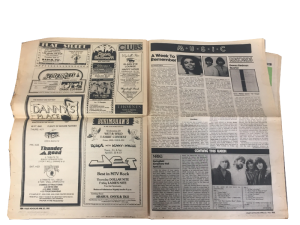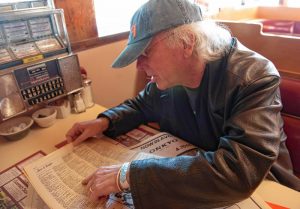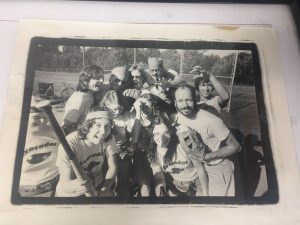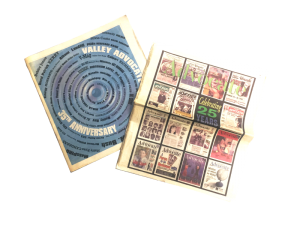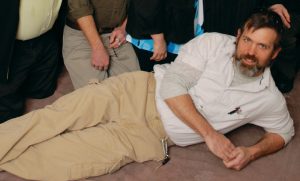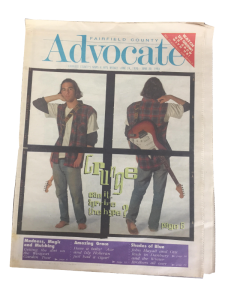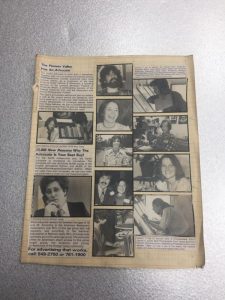The first edition of the Valley Advocate was published on Sept. 19, 1973, with a cover story titled, “Prophet & Profit — ‘Spirit’ Dies,” about a large hippie commune in Leyden called “The Brotherhood of the Spirit,” which became defunct when more than half of them quit. So it’s no wonder why 40-year Advocate journalist Stephanie Kraft says that during the alternative weekly’s early years “a lot of people saw us as this little hippie rag.”
“When I started work at the Advocate in 1974, just a year after its founding, I became part of a motley crew with a passionate interest in news and arts and very little training in journalism,” Kraft wrote in a 2008 editorial titled “A New Voice in the Valley,” about her early experiences with the Advocate.
She wrote then that the staff included two reporters: Preston Gralla, who covered the Amherst-Northampton beat and Eric Benjamin who worked in the Advocate’s Springfield office writing music stories when he wasn’t writing investigative exposes about the Springfield Police Department.
The Valley Advocate was founded by two former Hartford Courant reporters — Ed Matys and Geoffrey Robinson, who pooled $1,500 a piece, to start the Valley Advocate in 1973, Kraft said in a recent interview. The two other founders in the endeavor were their respective partners — Christine Austin and Linda Matys O’Connell.
She said they believed news should be selected with a more progressive and critical eye, whether they were offbeat stories that daily publications wouldn’t touch or stories that “assumed that homosexuals weren’t deviants” and that “the environment was not just OK because it was in the hands of the government.”
Later, Robinson and Austin took up ownership roles for New Mass Media, Inc., the parent company for the Advocate. The company published five different editions of the Advocate up and down the Interstate-91 corridor throughout the 1980s and 1990s, each with its own staff.
There was the Valley Advocate flagship, based in Amherst, and then later Hatfield, the Springfield Advocate, which had an on and off again relationship with the Valley Advocate, before the Springfield Advocate finally closed in the late 1990s and it merged for good with the Valley Advocate. There were also three Advocate in Connecticut, which were based in Hartford, New Haven, and Fairfield County, which are now out of print.
New Mass Media sold the Valley Advocate and its three sister publications to the Hartford Courant in 1999. And then the flagship Valley Advocate was sold to Newspapers of New England, which also owns the Daily Hampshire Gazette and the Recorder, in 2007, and offices were moved from Eastworks in Easthampton to its current location in the Daily Hampshire Gazette building on Conz Street in Northampton.
Now, more than 45 years later, with thousands of published stories ranging from in-depth investigative reporting to arts and music articles and reviews, political news coverage, sex advice columns, and environmental reporting, the Valley Advocate has carved out its own legacy in the Valley.
During the past 45-plus years many reporters and editors who have left the Valley Advocate have gone on to publish books, start their own businesses, and become recognized nationally for their journalistic work.
These Advocate alumni include non-fiction author Jonathan Harr, who wrote about a water contamination case in Woburn in the 1980s in his best-seller book, “A Civil Action,” as well as author/preacher/radio host Michael Eric Dyson, who wrote R&B record reviews for the Advocate.
But those are just some of the bare bones facts about the nearly half-century history of the Pioneer Valley alt-weekly. What was it like working at the underdog alt-weekly during its early beginnings? And what were the breaking print news stories that the Advocate covered in the days before the internet; many of which haven’t been archived online?
Kraft, who was a reporter at the Advocate from the age of 30 to 70, when she retired in 2014, started as a part-time reporter a year after the alt-weekly began its run. In 1974, she had just completed her doctorate degree in English, but it was difficult for her to find a teaching job. She saw that the Advocate was looking for writers and applied.
“I had a Ph.D. in English at a time when the bottom had fallen out of the market for teaching in English at the college level,” explained Kraft, now 75 years old. “I had a friend who filled in a year waiting for a teaching job by working at a newspaper and really loved it.”
Advocate founder Linda Matys O’Connell gave her her first freelance story — a review on a book about alligators — which she was paid $3.50 for.
“I said, ‘Linda, I don’t know anything about alligators or biology.’ She said, ‘Neither does the reader. You’re starting at the same gate as the reader,” Kraft said.
In the years that followed, Kraft wrote in-depth environmental investigative stories for the Advocate — one published in the mid-1980s was about UniFirst, a company in Indian Orchard, that cleaned the uniforms of workers at nuclear power plants and other places that handled radioactive material. That cleaner, it turned out, was sending a steady flow of radioactive water into the Springfield sewer system, she said.
“Very few people in the Valley even knew it was there, so I did a story about it, which I think was the first fairly long story that had been done about that company. This was gratefully received by a lot of people who had no idea. One of the surprising things that I learned was that the uniforms were laundered with nothing special; just ordinary washing soap in washing machines,” Kraft said.
She added that the Advocate’s story did not result in the Nuclear Regulatory Commission investigating the issue because the commission only regulates radiation based on longtime averages, not based on short term higher than allowed occasional radiation leaks. Local neighborhood members lobbied the state’s Department of Public Health to also investigate, but were unsuccessful. However, she said the story did result in a heightened public awareness about the dangers of nuclear energy.
Another story the Valley Advocate broke during the 1980s was by reporter Kris Hundley, who discovered that Francis Pilecki, then president of Westfield State College (now Westfield State University), had allegedly been sexually assaulting male students, Kraft said.
She said Hundley interviewed the mother of one of the victims who told her about the alleged sexual abuse after Hundley revealed that the state of Massachusetts knew about the allegations, but despite this, was planning on moving Pilecki to a position at the University of Massachusetts Amherst. But after the Advocate broke that story, Pilecki didn’t get that job, which Kraft said she believes was due to the Advocate’s investigative story.
The aftermath of the allegations eventually did lead to a trial against Pilecki, then 52 years. According to an archived article by the New York Times from January 1987, a jury found that Pilecki was not guilty of sexually molesting a student at the college. The jury deliberated for about eight hours over the course of two days before acquitting Pilecki of two counts of indecent assault in 1984 against one student, who went on to become a college administrator.
The ethos around the Advocate office was that they should find “whatever story they could drag in; like a cat dragging in squirrels,” Kraft said.
“We were all quite inexperienced, but whatever we could drag in; if we could prove it, they would print it,” she added. “It could be unflattering to some advertiser. It could be unflattering to a government official on all levels of government. All that was required of us was to be able to prove it and they would print it.”
David “DR” Reid worked for the Valley Advocate from 1975 to 1986, first in production, proofing copy, and later also as a reporter for the alt-weekly. Since the beginning, he believes the counterculture spirit of the 1960s influenced the Valley Advocate’s approach to news.
“We’re going to stop this fucking Vietnam War; we’re going to oppose nuclear weapons. The women’s movement was there. There was an anti-Nixon; anti-bullshit thing going on,” Reid, now 68, recalled during an interview at a coffee shop in downtown Northampton.
And when Reid was writing investigative news cover stories during the early 1980s, he said it was all about writing the kind of in-depth stories that other publications in the area didn’t investigate.
He wrote stories such as “Pistol Packing at Packard’s,” about a brawl at the Northampton bar, which involved off-duty police officers, according to the headline from the April 20, 1983, cover story.
Another story from the 1980s, titled “Secret Cargo,” was about radioactive waste being transported by secret rail cars through the Valley. Marvin Resnikoff, a staff scientist and coordinator of the Sierra Club’s Radioactive Waste Campaign, told the Valley Advocate at the time that none of the commercial sector cars had been physically tested for radioactive leaks and he knew nothing about cargo cars related to the U.S. Department of Defense.
Kitty Axelson-Berry was editor-in-chief at the Advocate from 1985 to 1994 and said during her tenure with the Advocate, investigative journalism remained the gold standard for the alt-weekly.
“Investigative reporting was the most important thing that we were doing,” she explained. “We really did a good job on exposés and digging into corruption and important things that were new to me.”
She added the Advocate tried to write stories that were “cutting edge,” and ahead of other local news organizations. One example: a story about cross-dressing in the early 1980s, which at the time was something the general public didn’t know much about.
In 1981, the Advocate moved from its Amity Street office in Amherst to a former mill building in Hatfield where all five editions of the Valley Advocate were printed. Staff in production would work on weekends, sometimes late into the night and early into the morning making sure the Advocates were published. Reid and production manager David Sokol, who was also a music editor, didn’t have a free weekend for more than a decade.
“The heart of this place wasn’t just the news guys, it was the production department because nothing was going to get out unless we did it,” Reid explained. “The shit rolled down hill. We were in the basement.”
Reid left the Advocate in 1986 and went on to become an 18-year municipal beat reporter for the Springfield Republican, then left the Republican in 2007 and is now an independent legal researcher. He said four or five Apple IIc 1980s computers paired with typesetting machines helped his job in production, but producing multiple weekly newspapers involved more manual work compared with today’s technology.
“They could do the typesetting for all the different ads. And the stories would come out in rolls of yellow paper with holes in them,” he explained. “You would tape the name of the story or the ad or whatever. And then you’d set parameters in another machine and it would spit out film. And that film we would have to run through a wax machine and paste that up according to the layouts. It was a massive project.”
Sokol, who started working at the Valley Advocate as a freelancer in the mid-1970s while he was a student at the University of Massachusetts Amherst, described his role as production manager as “grueling” with “non-stop deadlines.”
He added, “I could not come home from work without having a couple of drinks every night. It was so stressful. Not only did we have to meet those deadlines and get the papers produced and off to the printer every day for a different paper, but with my job there couldn’t be any mistakes.”
Although jobs were stressful at the Advocate office, the atmosphere was less stringent than a typical 9 to 5 office job, Reid explained. It wasn’t uncommon to see people smoking pot on the job even though marijuana was illegal.
Outside of the office, Advocate workers in the late 1970s organized a softball team called “Avocados.” There’s even a regular poker game that people working at the Advocate started, which continues on after 39 years.
“It seemed like The Advocate was kind of the perfect place to be during those years,” Sokol said during an interview in his Hadley home. “I can’t begin to tell you all the friendships that were created during all those years working with people. The people that I consider some of my closest friends are friends that were made during those years, in my case, writers and editors, even sales people, and certainly people from the production department.”
Despite the friendly working atmosphere and comradery, there were times of grief. The tragic murder of 33-year-old former Advocate writer Judith Hart Fournier in September 1992 by an ex-boyfriend, Bob Sawyer, who also wrote album reviews for the Advocate, was one such time.
The cover story for Sept. 24 through Sept. 30 was “The Law Could Not Protect Her,” by reporter Al Giordano with a black and white photograph of Fournier surrounded by a purple and gold frame.
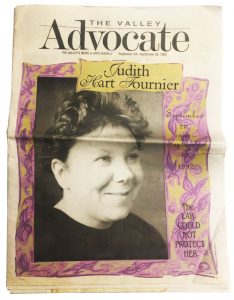
A cover story about the murder of former Advocate writer Judith Hart Fournier. David Sokol collection
Fournier had been working 20 hours a week at the Brattleboro Reformer and had recently came out to a number of friends as a lesbian.
Kraft said the murder was a tragedy that was contrary to the Advocate’s feminist values and was doubly upsetting for those who worked at the alt-weekly.
She said the staff felt grief at Fournier’s death and felt a betrayal by Sawyer, whom they thought shared the Advocate’s feminist values and would not engage in domestic abuse and violence.
According to the article, Sawyer stabbed Fournier about 3 p.m. at a gas station on Putney Road in Brattleboro. At the Brattleboro Memorial Hospital, she was pronounced dead at 7:10 p.m., “the knife still in her.”
Despite Fournier having a restraining order on her murderer, “The legal system proved as impotent as the thin envelope on Sawyer’s passenger seat in containing the knife that ended her life,” the article went on to say.
In “A Candle in the Wind: A Personal Remembrance,” by Sokol, he wrote, “Judy’s persistence, charm, sense of irony and general knowledge of the music business, with all its quirks and treasures, were the building blocks of a writing style that glittered and glowed as it evolved. Judy could write about anything.”
Investigative journalism, politics, and hard news have always been an important for the Valley Advocate, but local arts, music, and theater have also played a role in shaping the alt-weekly.
“Stagestruck” theater columnist Chris Rohmann has been writing for the Advocate since 1986 and has been writing for the Advocate longest of the people who contribute today.
Having grown up in a theater college community in Yellow Springs, Ohio, during the 1950s, Rohmann played child characters in Shakespearean works at the age of 10. When he opened the pages of the Valley Advocate in 1986 and saw a review about a local Shakespeare production, he thought it was awful.
He continued, “So I called up the Advocate and said, very unlike me, ‘The guy who’s writing about theater doesn’t know what he’s talking about. Would you like to have someone who does?’ And there was this pause on the end of the line and then [the Advocate editor at the time] said, ‘Sure.’ And I’ve been doing it ever since.”
Rohmann is one of the primary theater reviewers in the Valley and although he enjoys being known for his work, he added that there used to be many more.

Rohmann directing a play for the 24-Hour Theater Project, Northampton Center for the Arts in 2010. File photo
“The Gazette used to have regular-ish reviews of plays — Larry Parnass did a lot — but they have not for some time,” he explained. “The Republican does not, as far as I know. So, I guess I’m the theater guy in the Valley by default, at least in print.”
But theater in the Valley has changed a lot since the mid-1980s when Rohmann started writing for the Advocate. For starters, he explained that theater companies such as the aforementioned Stage West is now defunct. But smaller theater groups such as Serious Play! and other groups have grown and become an important part of the theater community in western Massachusetts.
Rohmann, who is also a theater director and most recently directed “Tar2F! An Irreverent Musical Comedy” for Silverthorne Theater Company in 2018, said being a theater critic for the Valley Advocate has become a major part of his personal and professional identity.
Axelson-Berry, who went on to become founder and owner of Amherst-based private memoir publishing company Modern Memoirs in 1994, said there were editors for music, arts, and calendars at the Advocate when she was editor-in-chief.
“I totally respected the arts editor and the music editor to do their thing way better than I could do it,” she added. “And the same with the calendar editor.”
From the 1970s and throughout the 1980s and 1990s, Sokol wrote as many music stories as he could. His first assignment, assigned to him by Advocate reporter Eric Benjamin, was to write about a show with Southern rockers The Marshall Tucker Band, bluesman James Montgomery, and blues rock guitarist/bandleader Elvin Bishop.
“He said, ‘I don’t care if you see Marshall Tucker or Elvin Bishop, but you have to come back with an interview with James Montgomery,’” Sokol said. “He put the fear of God in me.”
After that experience, Sokol felt comfortable writing for a professional news and arts publication. Early on, he also wrote a review about a Paul Simon album, which he was paid six cents a line for. He ended up making $3.60 for that 60-line review and spent the money getting lunch at Friendly’s.
He added the Advocate published record reviews, year end best-of-the-year music wrap ups by different reviewers, and coverage of local concerts from Brattleboro down to Hartford featuring local and national acts.
“I look back and look at the reviews that I wrote about David Bowie or Queen or Earth, Wind, and Fire at the Springfield Civic Center and they were great shows,” Sokol said. “It was just awesome that we had the space to write about them. Probably what I liked most of all was being able to write about local area artists. I got tons of space to write lengthy Q&A interviews with some of the really cool bands of the time.”
Just a few of the many local bands in the Valley during that time that Sokol recalled are the Jim Kaminski Band, Wendell-based reggae band Loose Caboose, Clean Living, and legendary Western Mass rockers FAT.
In the 35th anniversary edition of the Valley Advocate published in September 2008, Sokol wrote a retrospective piece titled, “The Music Went Round and Round … and came out here,” in which he recalled cover stories on Bob Dylan and Frank Sinatra, the Beach Boys, former Iron Horse owner and co-founder Jordi Herold and interviews with Tom Waits, Aimee Mann and Roger McGuinn of The Byrds.
“More than anything else, I’ll always remember the great energy that swirled around the Advocate offices in Amherst, and later Hatfield,” he wrote. “The sky was the limit, and there was always music in the air.”
Sokol left the Valley Advocate in the 1990s to become editor-in-chief of national country/ roots magazine New Country, which is no longer being published. Decades later, he was co-host of Sokol Heroes on WRSI 93.9 The River, a show he produced alongside his son Michael Sokol that ended its three year run this past year. It featured music with roots in the Pioneer Valley dating back to the 1960s.
Tom Vannah started working as an editor at the Advocate on June 12, 1995, at the age of 35. Prior to that, he had been living and working in Boston. In high school and college he said he was “gung-ho” to become a reporter, but after leaving college in 1982 he didn’t think he could become a journalist and took a job in the insurance industry.
“I always felt like something was missing and it took me until my late 20s to go back,” he explained, adding that his first reporting job was as a freelancer for now-defunct New England Business Magazine, where he had previously worked selling advertising space.
When he started working at the Advocate, the staffing was much more robust compared to today, he said. It included more staff writers, editors, photographers, graphic artists, and layout specialists. On average, the Advocate published 72 pages a week. But even in 1995, the Advocate had its ups and downs.
“The Valley Advocate was really in need of an infusion of life,” Vannah explained. “The people that were here were great, but there weren’t enough of them that knew about news, investigative reporting, and politics. The paper had gone to being really good at the arts, but not very important in terms of its news contribution. They tried to augment the arts coverage with really good national alternative news reporting, but it really wasn’t hitting the mark locally.”
Rohmann said he thinks Vannah’s tenure, from 1995 to 2014, was marked by a return to the Advocate’s roots as an alternative paper “in the old school sense of the term.”
“Tom brought that kind of energy. But having said that, I don’t think that Tom changed the editorial policy. It was kind of a more combative style in his own pieces and emphasis on what he wanted to cover,” he added.
Vannah said one of the stories that the Advocate covered during his time working at the alt-weekly was about the Heritage Bank collapse, a local bank that went defunct because fraudulent realty investors received million-dollar loans for fake projects in the Valley and pocketed the money. When the bank came asking for their loan, those who were involved in the criminal scheme said the funds were all spent due to development costs and the projects were unfruitful. These incidents involved a series of stories that were interconnected across the Valley.
“There many many local people who were hurt by that,” Vannah explained. “Before they failed, the FDIC puts pressure on the bank and the bank puts pressure on the creditors. So, a lot of local builders and heavy equipment operators, guys like that, lost their businesses because Heritage pulled their loans. And Heritage had to pull their loans because of the number of non-performing loans.”
In Springfield, Advocate writers broke a story that exposed a federal corruption probe into then-four term mayor Michael Albano, who left office in 2003 amid an FBI investigation into public corruption that resulted in members of Albano’s administration being convicted and sent to prison.
“What we tried to do, and I think this is true to all the people who have taken a turn working at the Advocate, is have a nice balance between being earnest and really caring about doing a really good job of the reporting and the writing and being literate, and accurate — and at the same time being a little bit impertinent or a little bit unexpected and fun.”
Growing up in West Springfield in the 1990s, Kristin Palpini would read the Valley Advocate on a regular basis. Decades later, in 2014, she became the alt-weekly’s editor-in-chief.
When Palpini came to the Advocate, after working as a reporter and editor for the Daily Hampshire Gazette starting in 2003, she said in a phone interview that her goal was to make some changes to the alt-weekly and “make it pop and noticeable.”
She added, “What I did was get rid of some of the older columns and whatnot that have been kicking around the paper for a while and had kind of lost their steam and momentum and replaced them with newer versions.”
Palpini said she felt like the Advocate needed to make some changes to account for modern times, particularly with regard to covering national issues.
“Because of the internet, things had changed a lot,” she said. “Back in the 1970s, getting your national political commentary from a weekly newspaper made sense, but not in the era that I came in. So, that was a change. Every now and again we’d comment on it or localize a national issue.”
Another change under Palpini’s leadership was trying to make the Advocate more fun, she said, adding that she felt the alt-weekly had become “too serious” prior to her tenure as editor-in-chief.
Among the cover stories during her era leading the Advocate, from 2014 to 2017, Palpini said she takes pride in a story she wrote in March 2015 titled “The $5 Trillion Debt — Do white Americans owe their black neighbors for slavery?” which was about offering reparations to African Americans for the hundreds of years of slavery in the country.
“That would really benefit the whole country,” she noted.
Another, by The Beerhunter columnist and former Advocate arts editor Hunter Styles, featured a profile of drag queen Hors D’oeurves of queer, sex and body positive Bon Appetit Burlesque on the front cover.
“It’s not every day that you get to put a drag queen on the cover of a publication and just send it out into the world,” Palpini said. “I thought that was just so cool.”
Although the Valley Advocate has published groundbreaking investigative news and has been a home to local arts for decades, there have been tough times, particularly in recent years. This month, the Advocate made its return to weekly after being published bi-weekly for about a year. For a six-month period ending in February, news content was also cut from the publication as part of a series of decisions that looked like they spelled the end of the Advocate.
But now with renewed investment in the publication through the restoration of Dave Eisenstadter as editor, Colleen McGrath as sales manager, and myself as associate editor, past Advocate staff shared their thoughts about the future of the Valley’s longest-running alt-weekly.
Vannah said when the Advocate returned to its weekly run this month after switching to bi-weekly for a year, he thought that was a change that was paramount to the success of the Advocate.
“You can not succeed on a bi-weekly,” he added. “I think people just won’t care if they don’t see it regularly.”
Vannah said if you look at the history of the Valley Advocate there is no villain when it comes to the financial ebb and flow; between the lean years with understaffing and the bountiful ones with stable staffing levels. He said he experienced both.
“You can’t blame anybody,” he explained. “You can’t blame the publishers. You can’t blame the advertising people. You can’t blame circulation. It’s just inevitable that economic realities running a newspaper in this Valley are such that you’re going to be constantly under pressure by the people that are trying to make money to quote ‘monetize’ the experience.”
Kraft said she would like to see a return to the local in-depth investigative journalism that the Advocate was known for throughout past decades.
“The investigative piece, I think, is the most important because out there beyond the newspaper business there is a realm of reality in the Valley, in which I’m sure there are things that really need reporting that are going unreported. The newspaper business is a means to an end and informing the public is the end … I’m sure people at the Advocate now, as always, aspire to due that investigating and need only the means to do it. I’m sure the motive isn’t lacking.”
Axelson-Berry said she’d also like to see a renewed commitment to investigative reporting in the current iteration of the alt-weekly.
“I just think that was the dandiest thing,” she said. “But it’s the hardest to do and you really have to keep advertising separate from the news end. It’s hard. It’s really hard. But there’s lots of room for more investigative reporting to be done.”
Kraft said she also thinks that more funds should be devoted to editorial staffing, adding, “Time is money and money is staffing.”
Rohmann said some people in the Valley are critical that the Valley Advocate has become “frothier and that it’s not interested in hard-hitting politics.”
He added, “I’m not sure I agree with that, except for the last year when news was off the pages entirely … That said, I will not say that the paper has gone soft and away from its original mission as much as a lot of other people do.”
Rohmann argued that the Valley Advocate doesn’t pay its freelance columnists enough money for their work either.
“It could and should pay more for freelancers,” he added. “I’m making much less per article than I was 20 years ago. I guess that’s an indication of journalism these days.”
Palpini said she thinks the regional news area in which the Advocate covers — from Brattleboro to northern Connecticut — is too broad of an area for the publication to cover with its current editorial staffing levels.
“I think that it should constrict a little or more staff should be hired,” she explained. “That’s always a good thing. That’s always an opinion I’ll have — hire more reporters.”
Above all, Palpini said she believes that the Advocate’s core mission is to provide news that doesn’t include mainstream voices and should focus on people like undocumented immigrants or those who live their lives on the margins of society.
“Paying attention to those people and their issues is something that I think the Advocate should never lose sight of and I don’t think it has,” she explained. “It should always stay true to its commitment to people instead of power.”
Chris Goudreau can be reached at cgoudreau@valleyadvocate.com.

